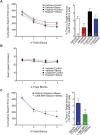Oxytocin Protects Hippocampal Memory and Plasticity from Uncontrollable Stress
- PMID: 26688325
- PMCID: PMC4685249
- DOI: 10.1038/srep18540
Oxytocin Protects Hippocampal Memory and Plasticity from Uncontrollable Stress
Abstract
The hippocampus is vulnerable to uncontrollable stress and is enriched with oxytocin receptors, but their interactive influences on hippocampal functioning are unknown. This study aimed to determine the effects of intranasal oxytocin administration on stress-induced alterations in synaptic plasticity and spatial memory in male rats. While vehicle-administered stressed rats showed impairment in long-term potentiation, enhancement in long-term depression, and weakened spatial memory, these changes were not observed in oxytocin-administered stressed rats. To reveal the potential signaling mechanism mediating these effects, levels of phosphorylated extracellular signal-regulated kinases (pERK) in the hippocampus was examined. Western blotting showed that oxytocin treatment blocked stress-induced alterations of pERK. Additionally, the oxytocin receptor antagonist L-368,899 inhibited the oxytocin's protective effects on hippocampal memory to stress. Thus, intranasal administration of oxytocin reduced stress effects on hippocampal synaptic plasticity and memory in rats via acting on oxytocin receptors and regulating ERK activity. This study suggests that exogenous oxytocin may be a therapeutically effective means to counter the detrimental neurocognitive effects of stress.
Figures



References
-
- Kim J. J. & Diamond D. M. The stressed hippocampus, synaptic plasticity and lost memories. Nat Rev Neurosci 3, 453–462 (2002). - PubMed
-
- McEwen B. S. & Sapolsky R. M. Stress and cognitive function. Current opinion in neurobiology 5, 205–216 (1995). - PubMed
-
- Overmier J. B. & Seligman M. E. Effects of inescapable shock upon subsequent escape and avoidance responding. J Comp Physiol Psychol 63, 28–33 (1967). - PubMed
-
- Foy M. R., Stanton M. E., Levine S. & Thompson R. F. Behavioral stress impairs long-term potentiation in rodent hippocampus. Behav Neural Biol 48, 138–149 (1987). - PubMed
Publication types
MeSH terms
Substances
Grants and funding
LinkOut - more resources
Full Text Sources
Other Literature Sources
Miscellaneous

